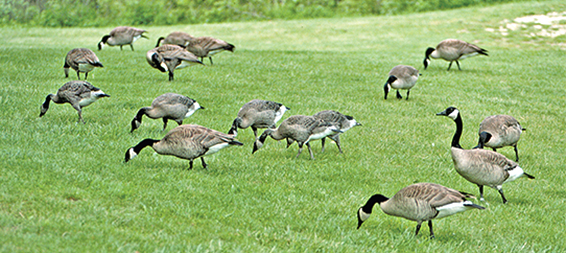Canada Geese Management
Introduction | Human & Habitat Modification | Abatement, Hunting & Permits | Questions & Answers

Introduction and Regulations
Less than fifty years ago, the giant Canada goose was extremely rare in Indiana. As a result of restoration efforts and a large increase in small urban and suburban waterbodies, Canada geese are now quite common. Many people enjoy seeing them fly in a v-formation or hearing their distinctive honk, but problems can occur when too many gather in an area.
The Migratory Bird Treaty Act (MBTA) of 1918 gave the United States Fish and Wildlife Service (USFWS) oversight authority to manage and regulate the harvest of migratory birds in the United States. This act makes it illegal to harvest waterfowl or other migratory birds except during the hunting season or by permit. It also prevents unrestricted egg harvesting and commercial hunting for meat and feathers. In 1999, the federal government introduced permits that could be issued to State wildlife management agencies so states and their designated agents could initiate Canada geese damage management within the conditions and restrictions of the permit. As such, the Indiana Division of Fish & Wildlife may issue permits for agricultural depredation and trapping activities concerning Canada geese.
A single, quick fix solution is unlikely to reduce or solve goose conflicts. Using several techniques in combination is a much more effective strategy. Short-term techniques can relieve immediate problems, but long-term solutions are much more likely to succeed in mitigating human/goose conflicts. The ultimate goal of Canada goose management is to reduce the number of conflicts, not to eliminate all geese. Canada goose management plans that are organized with an action plan, community buy-in, and time commitment are more likely to be successful. There is no single, best answer for Canada goose management.
It is best to use preventative techniques before a problem begins in an area. Once geese are established, it can become very difficult to deter them, particularly after nesting has begun. Think long-term management, not just short-term solutions.
Common Goose Conflicts
Typically, developers and landowners unknowingly facilitate human-goose conflicts by creating ideal goose habitat. Geese feed extensively on fresh, short, green grass. Manicured lawns and turf grass with nearby waterbodies such as retention ponds, lakes, and golf course water hazards create habitat for geese to set up residence, multiply, and concentrate. Geese, including their young, also have a strong tendency to return to the same area annually. Once geese start nesting in a particular place, it is likely more geese will nest there in the future. Congregating geese can cause damage to landscape. Large amounts of excrement, turf destruction, and aggressive behavior create potential conflicts.
Geese are particularly aggressive during breeding and nesting seasons as both males and females defend their nests. Their behavior can cause problems around businesses and other infrastructures when geese attack workers, residents, and customers.
Recognizing aggressive behavior in geese may help people avoid conflicts with geese. If defensive behaviors are observed, people should slowly walk away and give the goose space. Most injuries from geese occur due to tripping and falling while trying to run from geese. Defensive postures include head pumping, an open bill, hissing, honking, and wing flapping.
Many breeding pairs begin scouting for nesting locations in late February and most problems occur March through June during the nesting season. Egg-laying begins soon after nest construction is complete. Female Canada geese lay one egg every 1.5 days and the average clutch size is 5. Incubation of eggs begins after the last egg is laid and lasts approximately 28 days.
After hatching, goslings are incapable of flight for about 70 days, so the young birds and their parents will graze near the hatching area for that time. Adults also molt their flight feathers near the end of June, rendering them flightless for 15 to 20 days.
